9 business development cold email templates (and why they work)
Struggling with your cold outreach for business development? Discover 9 tactics (and templates) for effective business development emails.
Google Sheets has several built-in functions to help you perform calculations and find data in your spreadsheets. One essential function, especially if you work with large, complex spreadsheets, is the VLOOKUP function.
Google Sheets VLOOKUP saves you time and effort when locating specific data points or cross-referencing data in spreadsheets.
Learn how it works below.
<a href="#vlookup-intro" class="anchor-link">What is the Google Sheets VLOOKUP function?</a>
<a href="#vlookup-tips" class="anchor-link">5 important things to know about VLOOKUP in Google Sheets</a>
<a href="#create-vlookup" class="anchor-link">How to create your own Google Sheets VLOOKUP</a>
<a href="#vlookup-multiple" class="anchor-link">Copy a VLOOKUP formula across cells and compile data from multiple sheets</a>
<a href="#vlookup-business" class="anchor-link">Real-world business applications of the VLOOKUP function</a>
<div class="anchor-wrapper"><div id="vlookup-intro" class="anchor-target"></div></div>
VLOOKUP is a Google Sheets function that stands for “Vertical lookup.” This tool allows you to search for a specific entry in a column of data to find corresponding data from that row if there’s a match.
Think of it like looking for your grade on a posted list (back when that was the way people checked their grades, anyway). The professor puts up a paper with two columns: student names and grades. You scan the first column for your name, locate it, then move straight into the second column to find your grade. The VLOOKUP function does that manual searching for you and automatically returns the information you need, as long as there’s a match for your search.
The function formula is: =VLOOKUP(search_key, range, index, [is_sorted])
It includes the following four parts:
VLOOKUPs can also be used to find data points that may be spread across various sheets so you can compile your data. For SQL users, this is equivalent to a Left Outer Join.
Keep reading for examples and step-by-step instructions.
<div class="anchor-wrapper"><div id="vlookup-tips" class="anchor-target"></div></div>
Although the VLOOKUP formula seems simple enough at face value, there are a couple tricks to making sure you’re getting the correct data in your search results.
With VLOOKUP, your lookup value must be in the first (farthest left) column of the range you're working with. If the value is in a column to the right of the information you're looking for, the function won't work.
The VLOOKUP function in Google Sheets does not differentiate between uppercase and lowercase letters. For a case-sensitive lookup, you would need to use other functions or scripting.
VLOOKUP stops at the first match it finds. If there are multiple matches in your range, the function will only return the value associated with the first one it comes across.
In Google Sheets, you'll want to use absolute cell references for the range when applying the VLOOKUP function and copying it down or across other cells. For instance, instead of A1:D100, use $A$1:$D$100. Without these, when you drag the formula down or across, Google Sheets will automatically adjust the cell references, leading to incorrect results.
By default, VLOOKUP in Google Sheets performs an approximate match, which requires that your first column be sorted in ascending order. If you want to find an exact match, you need to set the optional fourth argument to FALSE. Without this, VLOOKUP might return unexpected results if an exact match isn't found.
<div class="anchor-wrapper"><div id="create-vlookup" class="anchor-target"></div></div>
To create your own VLOOKUP function, open up a Google Sheets spreadsheet. Ensure all your data is organized in clearly labeled columns and you know what you’re looking for. Then, put the function to work. Here’s how:
Stay organized by typing two labels below or to the side of your data: Search term and the label for the return value you’re looking for (Deal Size in this example). Type (or copy) your search term into the box next to the label. In this example, we’re looking for data related to the company Chopped in our list, so we use that as the search term. Make sure your search term is identical to how it appears in your data set.
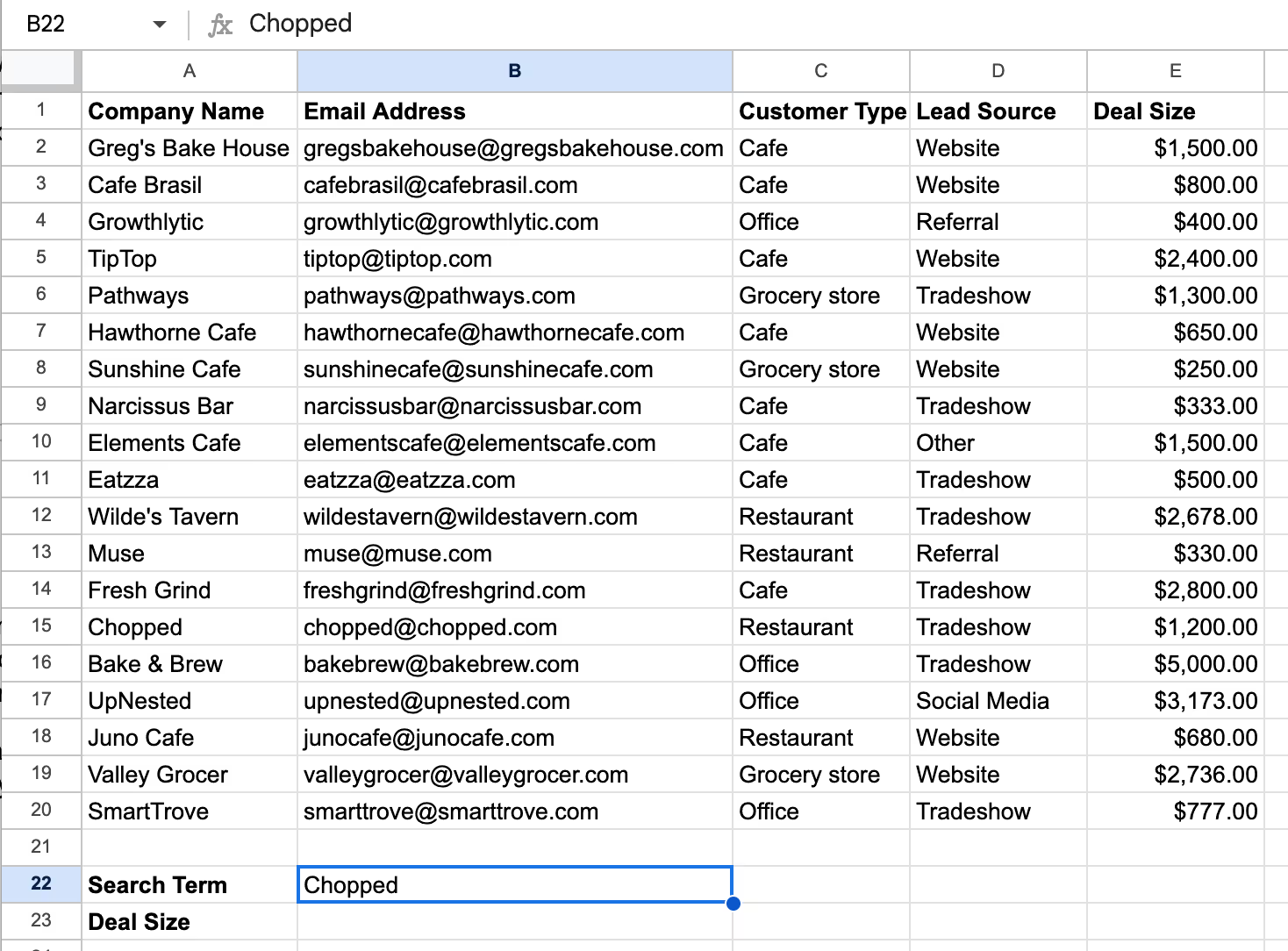
In the next box, start typing your formula with an equal sign followed by VLOOKUP and an open parenthesis.

The search_key portion of the formula tells it what piece of data you want to find a result for.
To select the search_key, click the cell containing your search term. In our example, this is the cell containing “Chopped”. When you type a different value into the search_key cell, the VLOOKUP will search for results corresponding with that value. Google Sheets will highlight the box you selected by outlining it with a colorful dotted line and the cell number will automatically fill in your formula. Alternatively, you can type the cell number - for example: “B22”.
Type a comma to separate the values in the formula.
The range tells your formula where to look by specifying what data to consider in the search. Enter the range by clicking and dragging on the spreadsheet to select all the data you want to include in your search. In this case, that’s all five columns of data in the spreadsheet. Add a comma to move to the next input.

The index tells your VLOOKUP which column it should pull the answers from. Type in the number (in digit form) of the column you want to retrieve data from, followed by a comma. Since the “Deal Size” information is in the fifth column from the left, we’ll type in the digit “5.” Do not highlight the column or enter the column name here—the formula won’t recognize those forms.
Type another comma for your final formula value.
For an exact match for your search term, enter FALSE or 0. Type in TRUE or 1 for approximate matching, but that’s generally not necessary. Finish out the formula with a closing parenthesis.

Press enter to see the results of your search. In this example, the function returned the result of a $1,200 estimated deal size for Chopped.

The first few times you use the function, you may want to check your results manually to ensure you’re entering everything correctly.
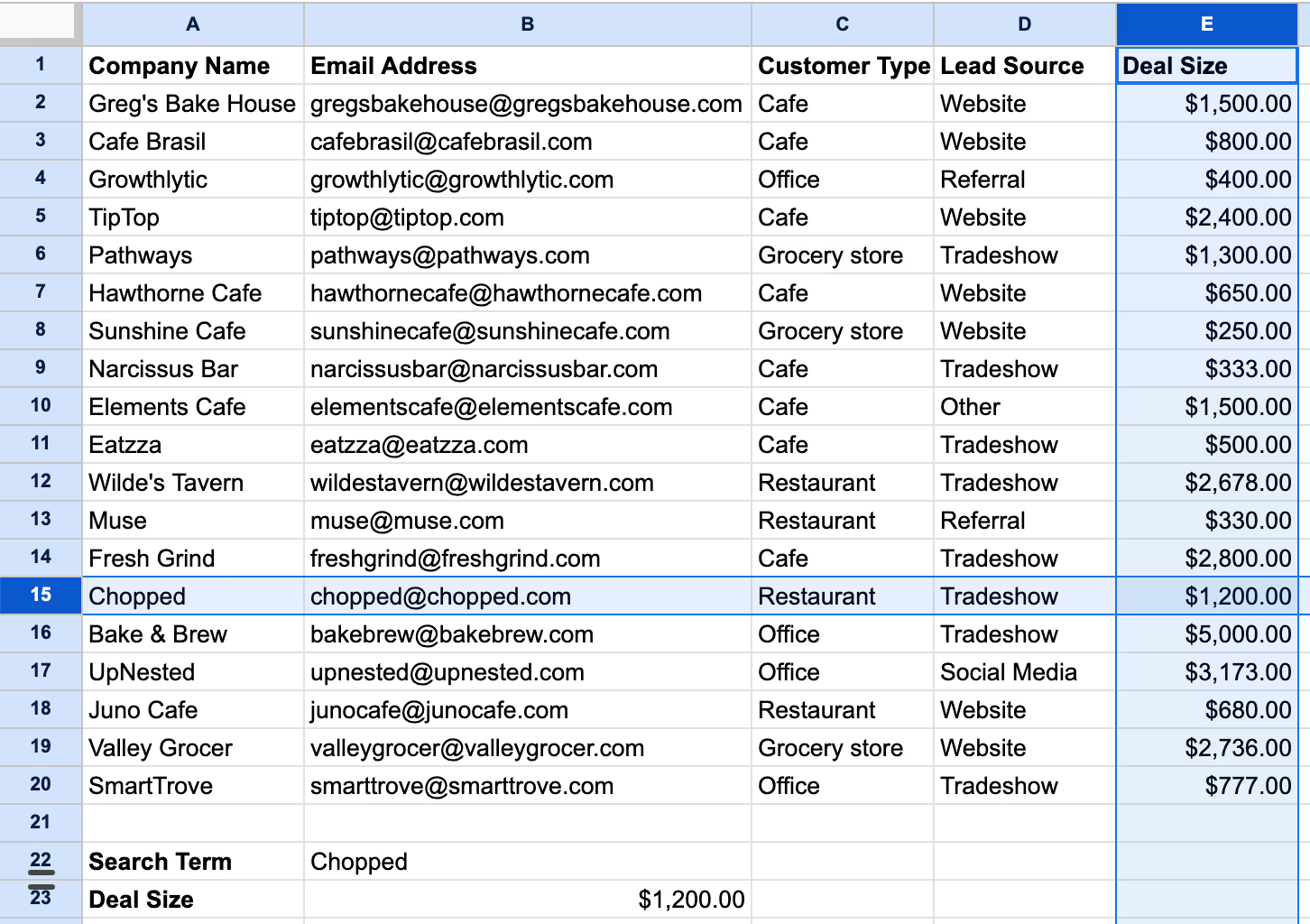
For this example, a manual search shows that the function returned the right deal size for Chopped.
<div class="anchor-wrapper"><div id="vlookup-multiple" class="anchor-target"></div></div>
Once you know how to create a VLOOKUP, it can be a powerful tool for spreadsheet users. A common problem that it helps solve is to compile or cross reference data in multiple spreadsheets.
For example, suppose a sales manager has two spreadsheets. Spreadsheet A contains sales data with a list of product IDs and the quantities sold, while Spreadsheet B has detailed information about each product, including the product ID, product name, and price.
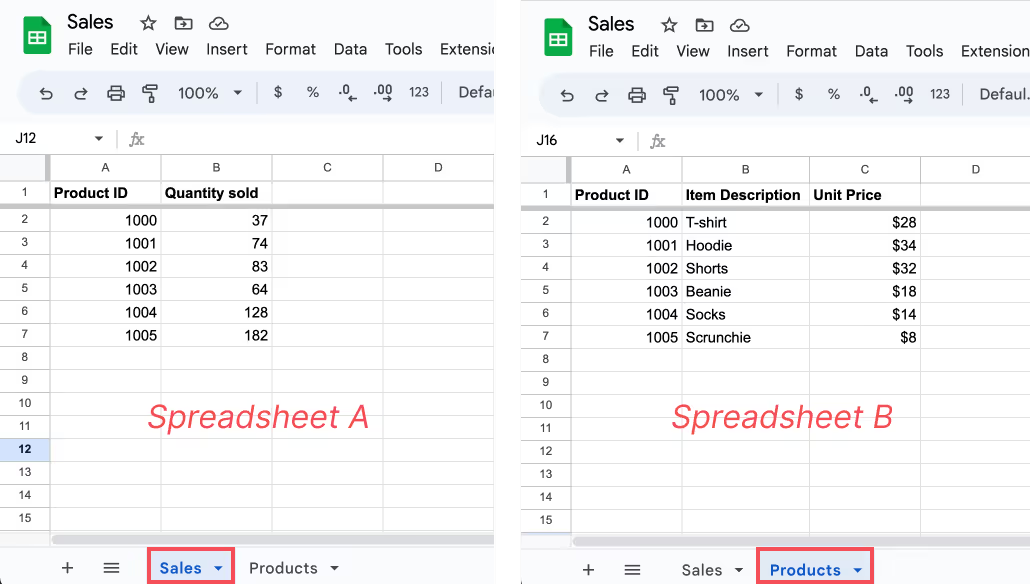
In order to calculate the total revenue from each product sold in Spreadsheet A, they need to know the price of each product. Instead of manually looking up and copying the price for each product from Spreadsheet B, they can use VLOOKUP to fill in the data in Spreadsheet A.
To achieve this, the VLOOKUP function can be copied across multiple cells of Spreadsheet A and use a range in Spreadsheet B.
Here’s how:
Start with a single spreadsheet document with all of your data in columns or separate sheets (tabs) of the same document, like the example above.
Make sure the column with the search_key is to the left of the column that contains your index (search results).
Write the VLOOKUP formula in a cell of Spreadsheet A.
Add the search_key, which would be the product ID or A2.
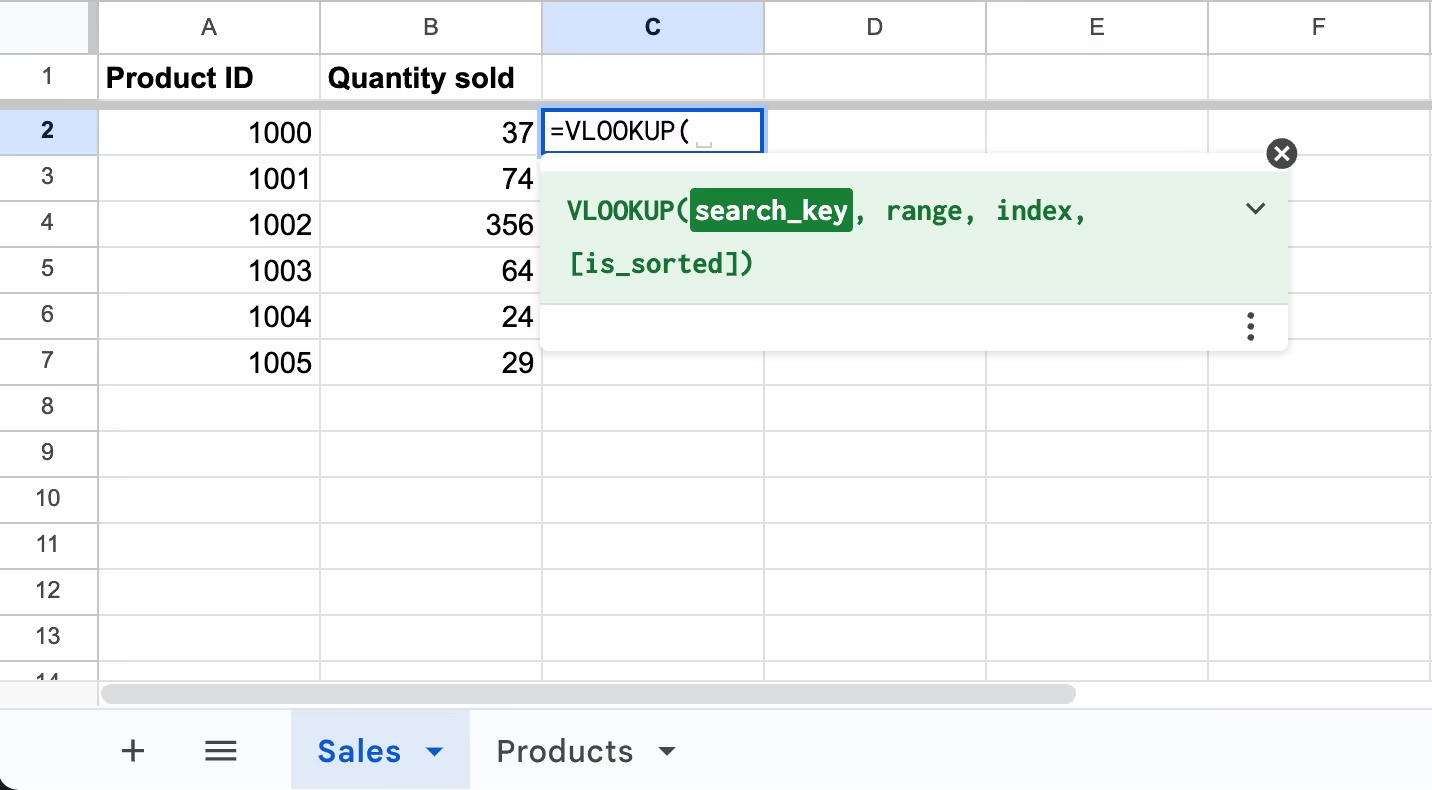
To reference a range in another sheet, simply open the other sheet and drag your cursor over the range you want to select. You’ll see the VLOOKUP formula carries over so you can keep working on it in this sheet. You can also type the name of the Sheet in single apostrophes before the range selection. For example: ‘Products’!A2:C6.
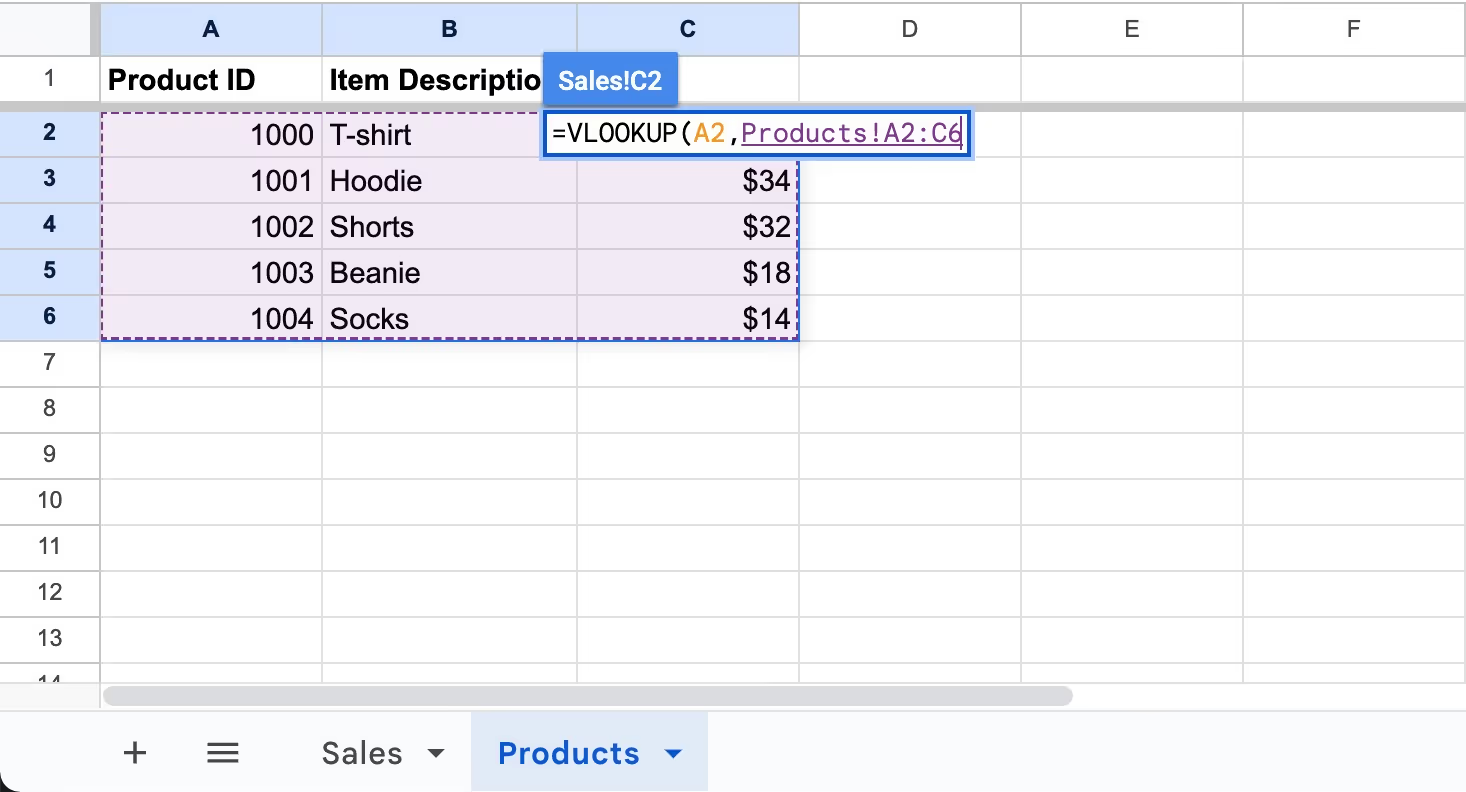
Type the number of the column where you’ll find the search results.
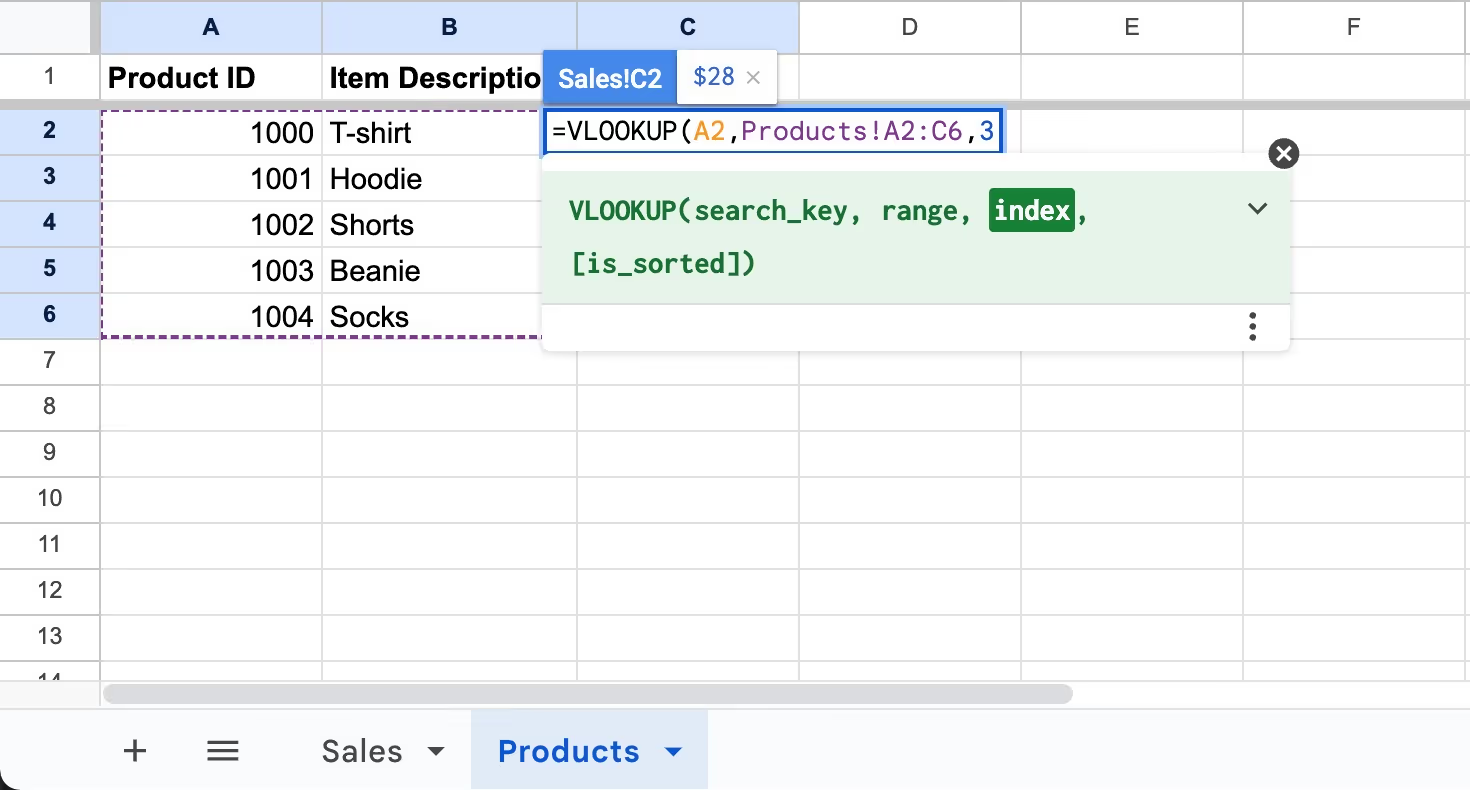
In most cases, you’ll want an exact match, so your is_sorted should be FALSE.
Add a closed parenthesis.
Enter your formula, and check that you’re getting the correct result in Spreadsheet A.

To copy the formula across multiple cells, click the blue dot in the bottom-right corner of the cell containing your VLOOKUP formula and drag it downwards to every cell where you want to return a result.
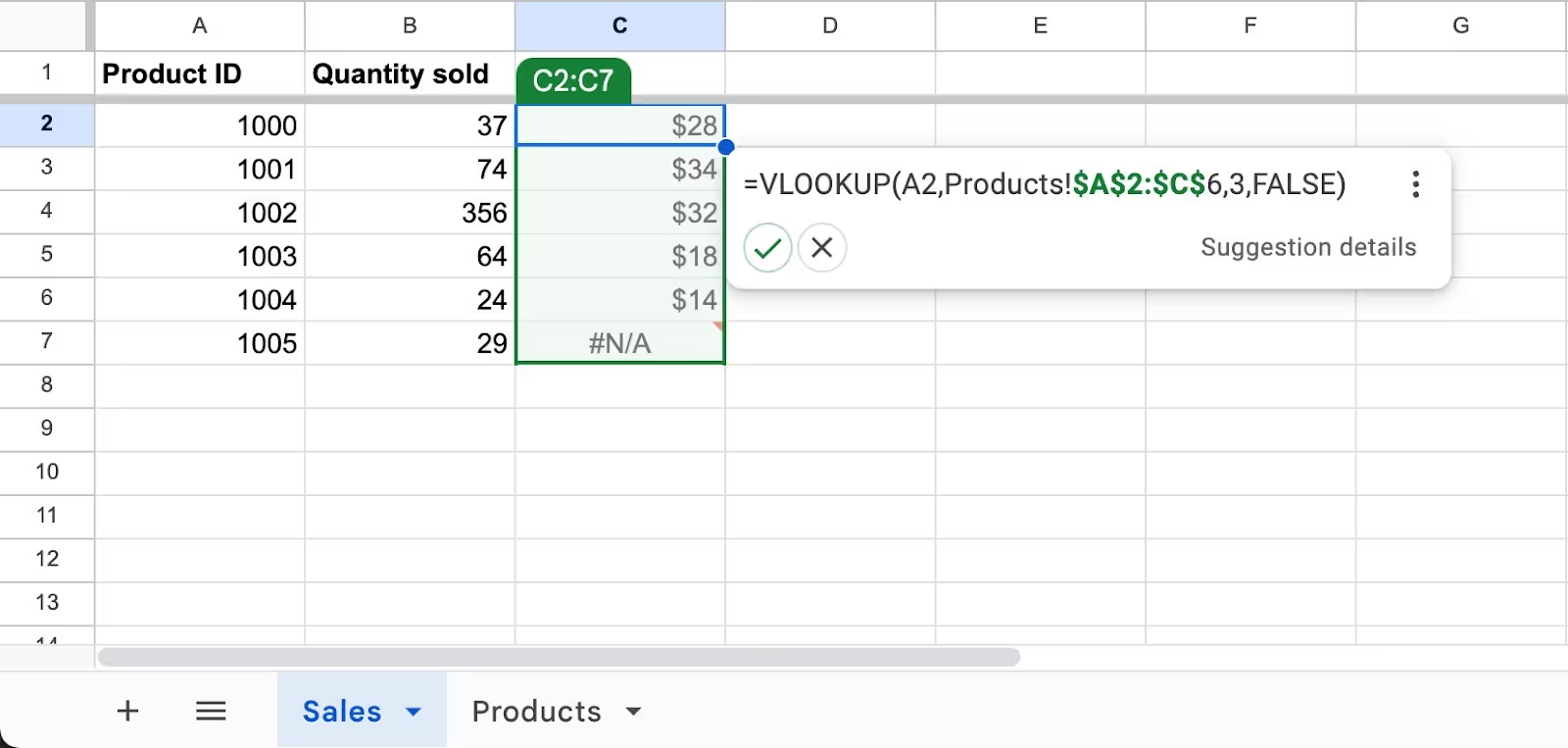
The function will be replicated in each of the selected cells, updating relative cell references according to their position. This feature allows you to perform the same lookup operation on an entire column or row of data, saving considerable time and effort if you're working with large datasets.
Keep in mind, if you need to keep certain cell references static (not changing when the formula is copied to other cells), you should use absolute references by adding a dollar sign ($) before the column letter and/or row number in the reference (e.g., $A$1). This will prevent those references from changing as you copy the formula to other cells.
<div class="anchor-wrapper"><div id="vlookup-business" class="anchor-target"></div></div>
At face value, the VLOOKUP function may seem like an abstract concept. To understand how powerful this can be, explore how you can actually use the Google Sheets VLOOKUP function in your workflow.
Anytime you have a large, complex spreadsheet and need to find specific data points, VLOOKUP is helpful. Using the function saves you the time and effort of manually digging through all your data to find the necessary information.
Many small to medium-sized businesses track their sales leads in lengthy spreadsheets. They record details like the lead’s name, contact information, lead source, budget or estimated deal size, and the products/services the lead is interested in. These spreadsheets quickly become unmanageable as the business adds more and more leads.
Say, for example, you have a sales lead spreadsheet with 100 leads and 16 columns containing details about each lead. That’s over 1,500 data points! If you need facts about an individual sales lead, it’s like looking for a needle in a haystack.
Instead of scanning your list of leads for the company you’re looking for and moving horizontally to the relevant column, use VLOOKUP. The function will return the information you need about the lead without manual searching.
Another scenario when VLOOKUP is useful is when you have a spreadsheet full of potential hires. As people apply for jobs at your company, you may record details such as their names, emails or phone numbers, the positions they’re applying for, and the people who referred them (if applicable).
When it’s time to interview one of these candidates, you probably want to have information like who referred them on hand. The VLOOKUP function retrieves this information from your potential hires spreadsheet without hassle.
You may also have spreadsheets full of sales and customer data to track order numbers, order values, customer names, and other details. These spreadsheets get so large and complex that there’s simply no good way to look through them manually. Luckily, the VLOOKUP function means you don’t have to.
Use VLOOKUP to see how much a specific customer has spent on your products or services, for example. Or, find an order number corresponding to that customer. VLOOKUP finds and returns those details so you don’t have to hunt them down in dense sales spreadsheets.
A warehouse might keep one spreadsheet with inventory details like SKU or barcode and another with corresponding item details such as cost, supplier, or item descriptions.
By using VLOOKUP, the warehouse could quickly access specific item details just by inputting the SKU or barcode. This simplifies the process of tracking inventory and can help quickly identify information like the cost of items or which supplier they come from.
The VLOOKUP function is Google Sheets is especially valuable when handling large volumes of data or managing datasets that are split across multiple sources, as it allows for rapid and accurate data matching. This function not only saves time but also reduces the likelihood of errors that could occur from manual data lookups.
A solid understanding of VLOOKUP can greatly enhance your data handling capabilities, making data analysis and reporting processes more efficient and reliable. Instead of spending time manually digging through spreadsheets, use the VLOOKUP function to pinpoint the data you need in just a few clicks.
